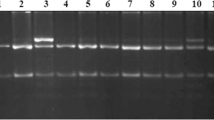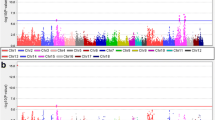Abstract
The fibronectin type III and SPRY domain containing 2 (FSD2) on porcine chromosome 7 is considered a candidate gene for pork quality, since its two domains, which were present in fibronectin and ryanodine receptor. The fibronectin type III and SPRY domains were first identified in fibronectin and ryanodine receptor, respectively, which are candidate genes for meat quality. The aim of this study was to elucidate the genomic structure of FSD2 and functions of single nucleotide polymorphisms (SNPs) within FSD2 that are related to meat quality in pigs. Using a bacterial artificial chromosome clone sequence, we revealed that porcine FSD2 consisted of 13 exons encoding 750 amino acids. In addition, FSD2 was expressed in heart, longissimus dorsi muscle, psoas muscle, and tendon among 23 kinds of porcine tissues tested. A total of ten SNPs, including four missense mutations, were identified in the exonic region of FSD2, and two major haplotypes were obtained based on the SNP genotypes of 633 Berkshire pigs. Both haplotypes were associated significantly with intramuscular fat content (IMF, P < 0.020) and moisture percentage (MP, P < 0.002). Moreover, haplotype 2 was associated with meat color, affecting yellowness (P = 0.002). These haplotype effects were further supported by the alteration of putative protein structures with amino acid substitutions. Taken together, our results suggest that FSD2 haplotypes are involved in regulating meat quality including IMF, MP, and meat color in pigs, and may be used as meaningful molecular makers to identify pigs with preferable pork quality.


Similar content being viewed by others
References
Ernst CW, Steibel JP (2013) Molecular advances in QTL discovery and application in pig breeding. Trends Genet 29:215–224
Andersson L, Haley CS, Ellegren H, Knott SA, Johansson M, Andersson K, Andersson-Eklund L, Edfors-Lilja I, Fredholm M, Hansson I (1994) Genetic mapping of quantitative trait loci for growth and fatness in pigs. Science 263:1771–1774
Paszek A, Wilkie P, Flickinger G, Miller LM, Louis C, Rohrer G, Alexander L, Beattie C, Schook L (2001) Interval mapping of carcass and meat quality traits in a divergent swine cross. Anim Biotechnol 12:155–165
Ovilo C, Clop A, Noguera J, Oliver M, Barragan C, Rodriguez C, Silió L, Toro M, Coll A, Folch J (2002) Quantitative trait locus mapping for meat quality traits in an Iberian × Landrace F pig population. J Anim Sci 80:2801–2808
Harmegnies N, Davin F, De Smet S, Buys N, Georges M, Coppieters W (2006) Results of a whole-genome quantitative trait locus scan for growth, carcass composition and meat quality in a porcine four-way cross. Anim Genet 37:543–553
Sato S, Hasebe H, Asahi Y, Hayashi T, Kobayashi E, Sugimoto Y (2006) High-resolution physical mapping and construction of a porcine contig spanning the intramuscular fat content QTL. Anim Genet 37:113–120
Bork P, Doolittle RF (1992) Proposed acquisition of an animal protein domain by bacteria. Proc Natl Acad Sci USA 89:8990–8994
Carsons SE (1989) Fibronectin in health and disease. CRC Press, Boca Raton
Hynes RO (2012) Fibronectins. Springer, Berlin
Ponting C, Schultz J, Bork P (1997) SPRY domains in ryanodine receptors (Ca(2 +)-release channels). Trends Biochem Sci 22:193–194
Fujii J, Otsu K, Zorzato F, De Leon S, Khanna VK, Weiler JE, O’Brien PJ, MacLennan DH (1991) Identification of a mutation in porcine ryanodine receptor associated with malignant hyperthermia. Science 253:448–451
Jeon JT, Park EW, Jeon HJ, Kim TH, Lee KT, Cheong IC (2003) A large-insert porcine library with sevenfold genome coverage: a tool for positional cloning of candidate genes for major quantitative traits. Mol Cells 16:113–116
Horwitz W, Senzel A, Reynolds H, Park DL (1975) Official methods of analysis of the Association of Official Analytical Chemists. Association of Official Analytical Chemists
Kel AE, Gößling E, Reuter I, Cheremushkin E, Kel-Margoulis OV, Wingender E (2003) MATCHTM: a tool for searching transcription factor binding sites in DNA sequences. Nucleic Acids Res 31:3576–3579
Stephens M, Smith NJ, Donnelly P (2001) A new statistical method for haplotype reconstruction from population data. Am J Hum Genet 68:978–989
Jacob M, Gallinaro H (1989) The 5′ splice site: phylogetic evalution and variable geometry of association with U1RNA. Nucleic Acids Res 17:2159–2180
Carim-Todd L, Escarceller M, Estivill X, Sumoy L (2001) Characterization of human FSD1, a novel brain specific gene on chromosome 19 with paralogy to 9q31. BBA-Gene Struc Expr 1518:200–203
Weintraub H, Davis R, Lockshon D, Lassar A (1990) MyoD binds cooperatively to two sites in a target enhancer sequence: occupancy of two sites is required for activation. Proc Natl Acad Sci USA 87:5623–5627
Fernandez X, Monin G, Talmant A, Mourot J, Lebret B (1999) Influence of intramuscular fat content on the quality of pig meat-1. Composition of the lipid fraction and sensory characteristics of m. longissimus lumborum. Meat Sci 53:59–65
Huff-Lonergan EJ, Baas TJ, Malek M, Dekkers J, Prusa KJ, Rothschild MF (2002) Correlations among selected pork quality traits. J Anim Sci 80:617
Cameron N (1990) Genetic and phenotypic parameters for carcass traits, meat and eating quality traits in pigs. Livest Prod Sci 26:119–135
Mancini R, Hunt M (2005) Current research in meat color. Meat Sci 71:100–121
Gjerlaug-Enger E, Aass L, Ødegård J, Vangen O (2010) Genetic parameters of meat quality traits in two pig breeds measured by rapid methods. Animal 4:1832–1843
Risvik E (1994) Sensory properties and preferences. Meat Sci 36:67–77
Acknowledgments
This work was supported by 15-51 Agenda research (PJ01022002) from the National Institute of Animal Science.
Author information
Authors and Affiliations
Corresponding author
Electronic supplementary material
Below is the link to the electronic supplementary material.
Rights and permissions
About this article
Cite this article
Lim, KS., Lee, KT., Lee, SW. et al. Genomic structure, expression and association study of the porcine FSD2 . Mol Biol Rep 43, 1011–1018 (2016). https://doi.org/10.1007/s11033-016-4029-4
Received:
Accepted:
Published:
Issue Date:
DOI: https://doi.org/10.1007/s11033-016-4029-4




